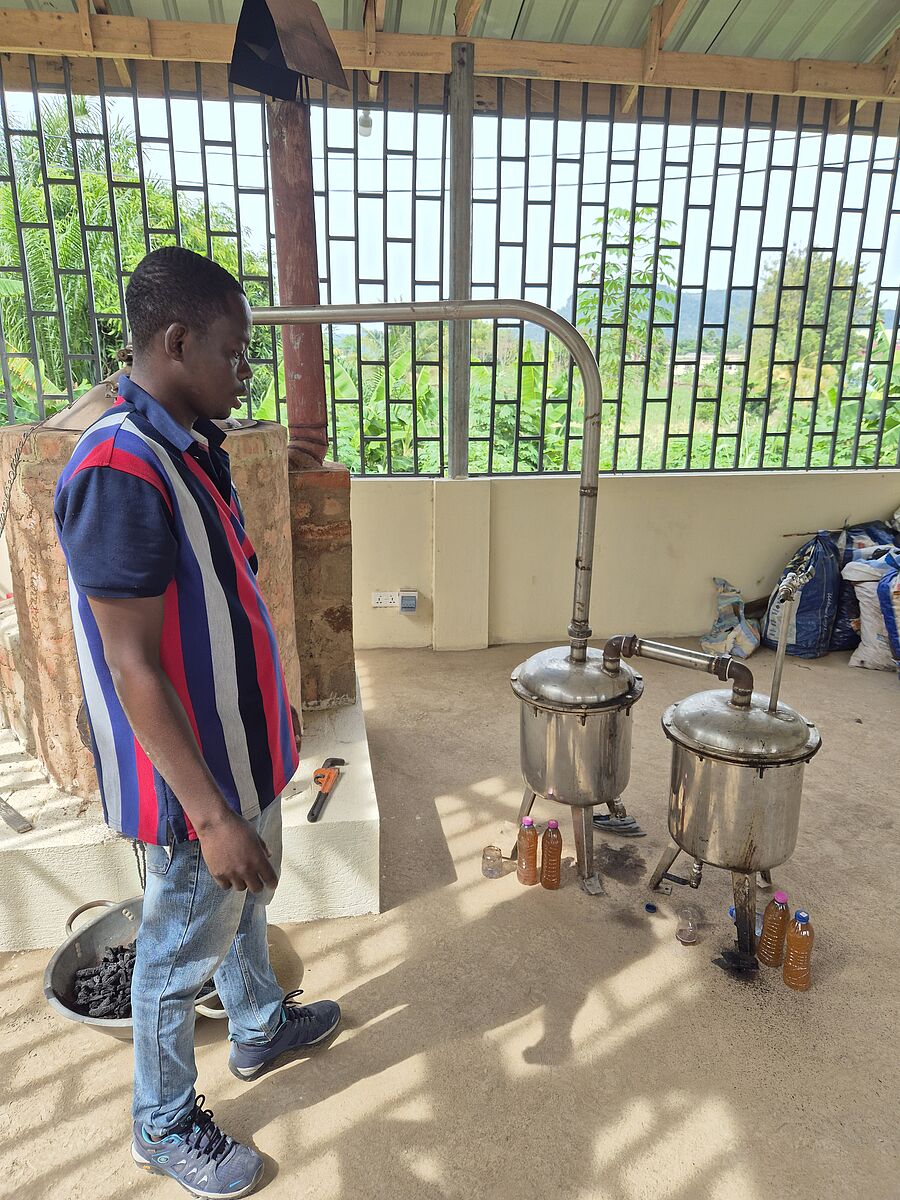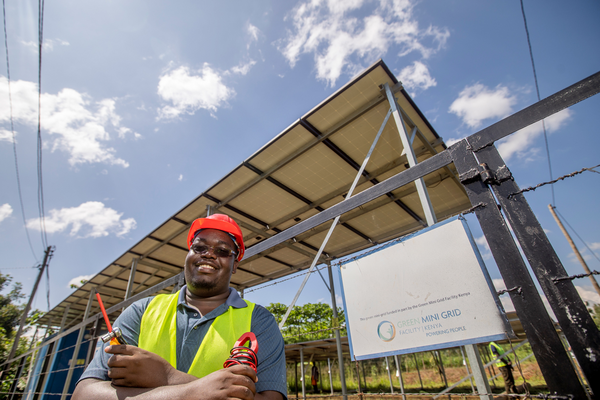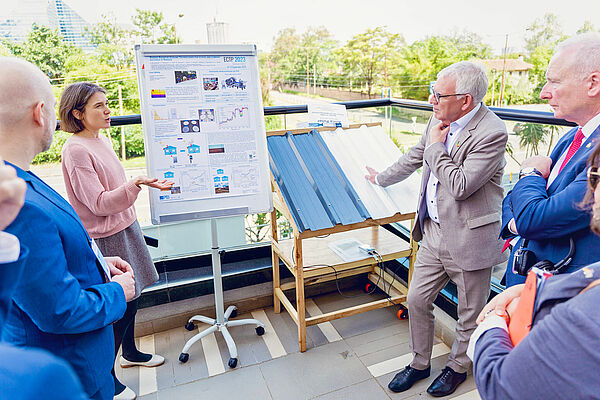Green concrete: cementing sustainable solutions

On the campus of Koforidua Technical University (KTU) in Ghana stands a mysterious cylindrical structure. Built from brick, with a steel dome and pipes that connect it to containers resembling pressure cookers, the structure is part chemistry lab, part mini power station, part time machine. But this really simple design is more than the sum of its parts – and may well help to solve a problem that will certainly impact Africa if its major cities continue to grow into urban metropolises. This is a pyrolysis plant that produces materials for the manufacture of cement and concrete – using agricultural waste.
The pyrolysis plant was developed as part of a collaboration between Ghana’s Koforidua Technical University (KTU) and Germany’s Bundesanstalt für Materialforschung und -prüfung (BAM). Funded (during the preliminary research phase) by the Federal Ministry of Education and Research (BMBF) and the Deutsche Gesellschaft für Internationale Zusammenarbeit (GIZ) GmbH, the project addresses an important problem: global cement production is currently responsible for eight per cent of global CO2 emissions. At the same time, Africa’s cities are getting ever bigger as people leave rural areas in search of work. Current reports (source: OECD, Africa’s Urbanisation Dynamics 2025)predict that Africa’s urban population will double in size from 700 million to 1.4 billion people by 2050. Forecasts suggest that the population of cities like Lagos, Nairobi and Dar es Salaam will swell to as many as 30 million (source). This will call for the construction of new housing on a massive scale, using huge quantities of cement and concrete – a constant source of climate-damaging CO₂ emissions. Curbing these emissions poses a major challenge for African countries – or could it also present an opportunity?
Working together on sustainable solutions
‘African challenges require African solutions,’ says Wolfram Schmidt. The senior researcher at BAM who helped launch the project now coordinates its work and regularly provides on-site support. ‘We can’t impose a ban on construction in Africa or force African constructors to use our technologies, thereby making the continent dependent on Western distribution channels,’ says Schmidt. ‘But we can help Africa to find its own climate-friendly solutions.’ In this case, the solution is simple: instead of disposing of residues that can be found in agricultural production everywhere in rural Africa, they can be used to produce biocement and green concrete. This not only reduces CO₂ emissions, it also cuts production costs. And it gives rise to new companies, creating local economic growth and new jobs. More money would remain in Africa, since it would no longer be needed for imports of cement.
For Wolfram Schmidt, the pyrolysis plant on the KTU campus is not just a project, it is part of a mission. With a PhD in engineering, Schmidt is an expert in building materials technology and has been working on the production of more sustainable building materials since 2009. Between 2016 and 2018, Schmidt and Dr Kolawole Olonade from the University of Lagos built a complete model construction using green concrete on the university campus. The raw material they used was the husk of the cassava plant, also known as manioc. Today the building serves, among other things, as an information centre for sustainable construction. In 2018, its two creators received the German African Innovation Incentive Award (GAIIA) for their research. Another award winner is Richard Arthur, who is carrying out research into water hyacinths as an energy resource. It was through him that Wolfram Schmidt made contact with KTU, which developed plans for the pyrolysis plant in collaboration with BAM and commissioned its construction on the KTU campus under the direction of Dr Bright Asante. But how are the residues of corn cob and cassava husks turned into durable construction materials?
From the KTU campus to the whole of Africa?
The idea of using natural products to produce building materials is thousands of years old. The Romans used ash from the volcanic eruptions of Mount Vesuvius to make mortar for buildings. ‘We have tended to glorify this period somewhat. In fact, the buildings were not that stable,’ says Wolfram Schmidt. ‘But the basic idea of using locally available materials is spot on.’ After around 18 months of project activities, including workshops involving industry stakeholders (Heidelberg Materials and Arup from Nigeria), the pyrolysis plant is now producing vegetable charcoal on a reliable basis. Project participants have already used two tonnes of organic waste to produce vegetable charcoal. Wolfram Schmidt estimates that ash produced from the charcoal could potentially replace 25 per cent of cement in concrete production. Once vegetable charcoal is burned to produce ash, it can be mixed into the concrete during production.
But that’s not the end of the story for bio-based green concrete: ‘I'm pleased that we finally have something tangible to show for our work. My dream is now to market the plant as a model for the whole of Africa.’ But for this we need partners – from the public sector and from industry. The Austrian company Neulandt, a subsidiary of Umdasch Group, financed the kiln components. The German company MC-Bauchemie provided laboratory capacity and was involved in project planning. A whole network of partners, including the United Nations Environment Programme (UNEP), Volkswagen Foundation, BMBF funding projects and GIZ, are working to ensure that African businesses and companies will be able to scale up the use of pyrolysis plant technology in the years ahead
Creating jobs, stemming the rural exodus
Wolfram Schmidt is now grappling with the question as to how the pyrolysis plant can be used even more efficiently. ‘In an ideal world, I imagine this system mounted on a pick-up truck, so it can produce and deliver at the same time,’ Schmidt explains. Another of his ideas is to locate a concrete mixing plant in the middle of a farming area, where raw materials are directly available. Both concepts could create new and technically interesting employment opportunities in rural regions to help stem the rural exodus. In either case, the production of bio-based concrete offers farmers an opportunity to generate additional income. Until now these materials were just waste; at best, they were composted. But organic fertiliser is also a by-product of pyrolysis.
Although production of bioconcrete and biocement is still in its infancy, the (global) market is certain to grow – and demand for the product may well be almost infinite. Africa would have a considerable market advantage, says Wolfram Schmidt: ‘In Germany, for example, soils are already in very heavy use and partially depleted, so they’re less suitable for producing additional biomass.’ Unlike Germany, African countries still have plenty of space. The potential to improve land use and efficiency in Africa is so great that current agricultural production could be increased ninefold with very little effort. Countries like Ghana, Nigeria and Tanzania, which produce a lot of cassava, could become less dependent on global markets thanks to innovative products like biocement. This would potentially benefit an entire network of companies – in fact any enterprise that can produce suitable biomass, process it in plants and sell it on.
From the Koforidua campus in Ghana to farms in Africa and perhaps across the world, this is just the start of a pioneering journey for the pyrolysis plant – that mysterious brick and steel structure on the KTU campus.
Published on

